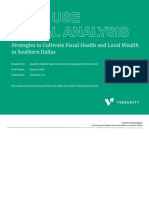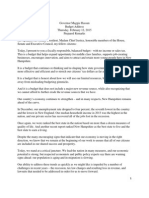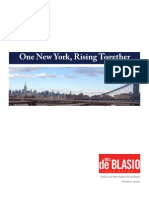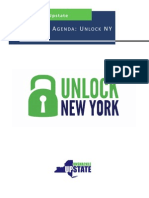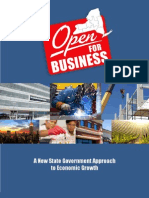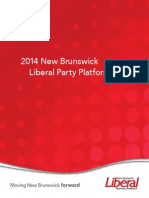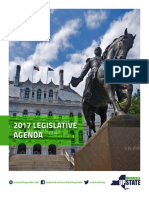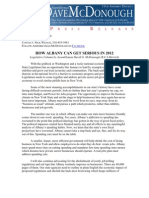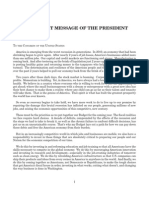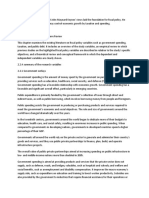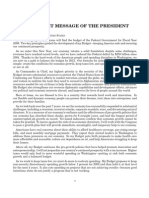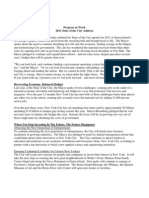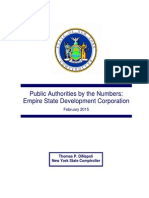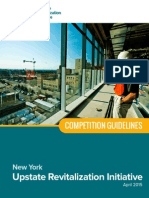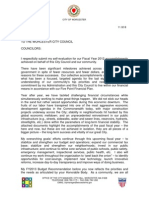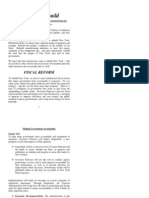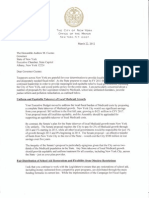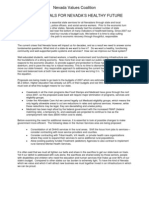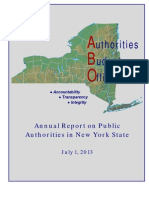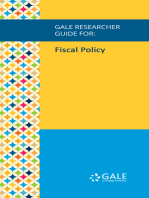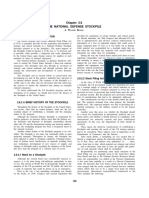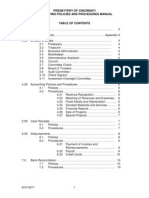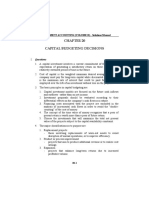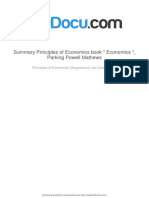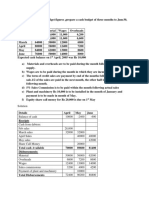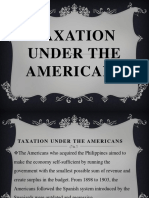New York at A Crossroads: A Transformation Plan For A New New York
New York at A Crossroads: A Transformation Plan For A New New York
Uploaded by
wqwerCopyright:
Available Formats
New York at A Crossroads: A Transformation Plan For A New New York
New York at A Crossroads: A Transformation Plan For A New New York
Uploaded by
wqwerOriginal Title
Copyright
Available Formats
Share this document
Did you find this document useful?
Is this content inappropriate?
Copyright:
Available Formats
New York at A Crossroads: A Transformation Plan For A New New York
New York at A Crossroads: A Transformation Plan For A New New York
Uploaded by
wqwerCopyright:
Available Formats
New York at a Crossroads: A Transformation Plan for a New New York
ANNUAL MESSAGE STATE OF NEW YORK January 5, 2011
To the Members of the Legislature of the State of New York: Today we are at a crossroads. We are at a time of crisis that has been created by national economic pressures, out of control State government costs and a dysfunctional political system that has lost the trust of its people. These forces have weakened our State and point us to a road to continued decline. And yet, New Yorks assets, legacy and tenacity suggest we can turn this crisis into an opportunity to fundamentally remake our State into the progressive capital of the nation. By working together, we can transform our State government and seize this moment to build a new New York for future generations. The time is now. What we do today will determine the trajectory of this State for generations to come. Let us make no mistake. Change is not easy, but we must change to return to prosperity. We must begin by confronting honestly the challenges
we face. In government, as in life, you can never solve a problem you refuse to acknowledge. As we take a different approach to governing, today we are presenting this message in a setting different from any modern State of the State message. This symbolizes the fundamental changes that will be ultimately productive and liberating for New York. Time of Crisis: Challenges The national economic decline has hurt New York especially hard. We are in the midst of the Great Recession where nearly 800,000 New Yorkers are unemployed and our people are facing the crush of the second highest combined state and local tax burden in the nation. New Yorks already hostile business climateranked 50th in the nationmust change if we are to have prosperity. Our government costs are simply unsustainable at this rate government employee pension and employee healthcare costs will collapse the State's economy. The cost of pensions and health benefits for active and retired employees will grow from $1.3 billion in 1998-99 to $6.2 billion in 201314almost a 476 percent increase. State spending continues to exceed income and inflation. From 2000 to 2010 State spending grew at an average rate of 5.9 percent, while personal income only grew 3.8 percent. Moreover, we face an ever-growing budget deficit this year of nearly $10 billion, but if we do nothing, it grows to
more than $14.5 billion in 2012-2013 and more than $17 billion in 2013-2014. Despite the exponential growth in the size and cost of our State government, we get little in return. Our schools, in many cases, are underperforming even though we spend the most in the nation on education. Our Medicaid program underperforms, although we spend 69 percent more per beneficiary than the national average. And its not just State government that has overgrownlocal governments have also multiplied. Many of our rising costs come from the fact there are more than 10,500 local governmental entities. New Yorkers see the dysfunction and theyre voting with their feet by leaving. We have one of the highest rates of out migration in the nation. Young people are leaving the State because of dwindling job opportunities. From 1998-2007 New York experienced a cumulative domestic out migration of approximately two million people, with 20 to 35 year oldsthe most critical demographic group for economic growth and community vitalityleading the way. The following is a roadmap for transformation. It lays out a plan that will allow New York State to become the Empire State in both name and spirit again. The actions it calls for are bold and they must be acted upon.
A Transformation Plan for a New New York We need a Transformation Plan for a New New York that will allow us to chart a course of growth and prosperity for generations to come. The crisis is our moment and we must seize the moment. Transform New Yorks Economy To begin, we must transform this State into an economic leader once again. What made New York the Empire State was its thriving private sector. The heart of our State shield shows two ships sailing on the Hudson. One is a schooner for coastal travel and commerce and the other is a sloop that is heavily rigged for international trade. Business built New York and we are declaring that New York is once again open for business. A key element of this program will be holding the line on taxes now while working to lower taxes in the future. To do this, our government needs a complete attitude adjustment, one that makes us job facilitators and not frustrating job creation. Create Regional Economic Development Councils We must change the way we engage in economic development planning and execution. Those working at the local level know their area economies best and we will empower them through the creation of regional economic development councils that can coordinate and integrate State
agency responses with local government and business activities to create jobs. These will not be advisory councils but instead planning and implementation councils that are empowered to allocate resources. Lieutenant Governor Robert Duffy will lead these councils to ensure every State agency is a job creator. The councils will draw their membership from a broad spectrum of backgrounds, from the private sector, to local government, to State agencies and even higher education leadership. We have a vast network of higher educational institutions in our State, which include our great SUNY and CUNY systems, and we need to better tap into their economic potential. While New Yorks universities rank second nationally in total research spending, they still lag behind other states universities in finding ways to commercialize New York research. One of the most important tasks of the regional economic development councils will be to assist those institutions in transforming their research into meaningful economic activity. The initiatives the regional economic development councils undertake have to produce measurable results. Competition will drive how scarce economic development resources are committed. The regional economic development councils will use performance standards to determine how funds are distributed within their
regions. At the same time, I will propose a fund where the regional economic development councils compete for $200 million of existing money to develop the best jobs development plan. Fixing the Recently Enacted Excelsior Tax Credit Program This past year, New York allowed the States Empire Zone tax credit program to expire and replaced it with a new, more targeted initiative called the Excelsior tax credit program. It was a positive and needed first step, but I will propose making several changes to strengthen the program. First, the Excelsior program offers a tax credit of $2,500-$5,000 per job for five years. My reform will give qualifying businesses a tax credit equal to 100 percent of the income tax receipts the State will collect from the companies new employees for a period of ten years. Second, the Excelsior program provides property tax credits based on the value of the property before any improvements made by the companythereby producing very little return on that kind of investment. My program will base the property tax credit on the value of a property postimprovement, which will ensure that the company realizes the full value of the credit. Third, Excelsior does not pay any credits until all of the promised jobs are created, even if the project was intended as a multi-year job-creation program. I will propose revising this element of the
program allowing the State to pay the credits as soon as interim milestones are achieved. Fourth, Excelsior now promises new R&D tax credits, but makes them unavailable if the company is taking advantage of other New York State R&D tax credit programs. This limitation will be eliminated and allow companies to expand their R&D tax credits. Fifth, we will streamline the application and approval process. When businesses are choosing whether to locate in New York or other states, New York economic development officials should be in a position to make commitments promptly regarding the availability of tax benefits. Use New Yorks Valuable Low Cost Power to Create and Retain Jobs and Spur Economic Development New York State produces a substantial amount of low cost hydropower through NYPA for the benefit of the public. While some of this power is used to reduce residential energy bills, the balance is used for economic development through several different programs. The only statewide initiative is the Power for Jobs program, which provides discounted energy to job-creating businesses and non-profits across New York State. The program needs legislative action for reauthorization, which has historically only been granted on an annual basis. However, this approach has not served anyone well. First, the programs have not been open to participation by new businesses.
Second, existing beneficiaries have been reluctant to invest in their facilities without the assurance that the benefits will continue for multiple years. Third, the year-to-year extensions have also hampered NYPAs ability to effectively administer the programs and execute long-term budgeting and hedging strategies. Finally, the last incarnation of the Power for Jobs program lacked critical incentives to reward participating companies for increasing energy efficiency, thereby saving valuable energy and resources not only for themselves, but also for all New Yorkers. That is why I will introduce a permanent Power for Jobs program, which ensures predictability and stability of supply with long-term contracts and incorporates efficiency incentives to reward such improvements. This will provide a valuable tool to help keep manufacturers in New York State, thereby growing the job base. Growing the States job base will be a fundamental component to my economic plan. As it has shrunk, fewer and fewer New Yorkers are left to shoulder the cost of government. This unfair cycle of rising costs being placed on fewer residents must be halted. Enact Property Tax Relief New York property taxes are out of control and are destroying the State. High property taxes are hurting our entrepreneurs, farmers and homeowners. Local property tax levies in New York grew by 73 percent from 1998 to 2008, more than
twice the rate of inflation during that period. When measured in absolute dollars paid, Westchester (1st), Nassau (2nd) and Rockland (5th) are among the five highest taxed counties in the nation. When property taxes are measured as a percentage of home values, 13 of the top 16 highest taxed counties were in New York. New York has no future as the tax capital of the nation and our people cannot afford to pay more taxes. That is why we need a property tax to give taxpayers relief. First, my property tax cap will be set at the rate of inflation or 2 percent, whichever is less. Second, any property tax levy increase above the cap would be prohibited, unless endorsed both by the local governing board and a 60 percent majority of the people. Third, all local governments and school districts would be covered, including fire and other special districts. Fourth, only limited exceptions would be allowed for the cap, such as one-time needs for large legal settlements or extraordinary capital expenditures. Redesign State Government However, a transformation of the States economy must coincide with a fundamental change in how the State governs itself. Only a radical change in both sectors will revitalize New York and make us a leader in the 21st century.
10
Without a serious effort to redesign our government, New Yorks future will continue to be stymied by inefficiency and redundancy. Our government has layers of overlapping and duplicative structures that have amassed since the last fundamental reorganization by Governor Al Smith in 1927. There are more than 1,000 state agencies, authorities and commissions. For example, the Department of Health alone has at least 87 statutorily created administrative units, including 46 councils; 17 boards; 6 institutes; 6 committees; 5 facilities; 2 task forces; 2 offices; 2 advisory panels and a work group. In addition, economic development efforts are balkanized across 28 separate agencies and hundreds of public entities with economic development missions. To modernize and rightsize State government, this administration will propose the Spending and Government Efficiency (SAGE) Commission whose charge will be to undertake a comprehensive review of every agency of state government and recommend structural and operational changes to it. The SAGE Commission will be directed by business leaders, with legislative input, whose expertise is in restructuring complex organizations, and its charge will be simple: make our State government more modern, accountable and efficient. It will reduce the number of agencies, authorities, commissions by 20 percent, in the
11
interest of saving taxpayers money, increasing institutional responsibility, and improving the delivery of government services. To ensure that the SAGE Commissions recommendations are implemented, I will introduce legislation entitled the State Government Reorganization Act that will authorize the Governor to submit a plan to the Legislature to eliminate, transfer and consolidate State agencies without further legislative approval. Once given that authority, I will submit the SAGE Commissions rightsizing plan to the legislature, which will have thirty days to reject it. If not, the rightsizing plan would go into effect. Numerous Governors around the nation have this power, and without it, this administration will struggle to ensure that special interests cannot block the governmental rightsizing we desperately need. Redesign Local Government In addition, we must continue to rightsize our more than 10,500 local governments through consolidations, mergers and shared services. Rewarding local governments that implement redesigned programs that create long-term recurring savings will help achieve that rightsizing. Therefore, I will introduce Citizen Re-Org Empowerment Grants that will cover all or part of the costs of merger and dissolution studies. These grants would automatically be awarded to communities that successfully voted to reorganize, merge or dissolve their local government. The funds will come from
12
the Department of States Local Government Efficiency Grants (LGEG), and would provide up to $100,000 to develop the comprehensive reorganization plan. In addition, I will create a special consolidation bonus pool. Every municipality in New York receives unrestricted local aid from the state called Aid and Incentives to Municipalities (AIM). Part of the AIM program includes additional state aid when municipalities merge or dissolve. The increased aid, however, does not have to be used for a particular purpose. I propose mandating a portion of the increased AIM funding which results from a local government consolidation or dissolution be given directly to taxpayers for immediate tax relief. Under this program, 50 percent of such additional aid would have to be used for direct reductions of real property taxes. Therefore, if municipalities merge or dissolve, citizens would be guaranteed that, at least, 50 percent of the total increased AIM aid would be allocated directly for property tax relief. Enact an Emergency Financial Plan The pressing nature of the crisis at hand calls for both immediate and strategic action. In the short term, I am proposing the following Emergency Financial Plan, which, when implemented will place our States finances on the firm foundation they need to be on in order to implement the strategic transformation outlined in this document. The plan will:
13
Close the more than $10 billion deficit in the 2011-2012 budget without new taxes or borrowing; Impose a one-year salary freeze on the vast majority of public employees whose contracts are up for renegotiation as of April 1, 2011; Hold the line on taxes; and Impose a State spending cap limiting growth in spending to the rate of inflation. Transform the Budget Process
The budget process must also be redesigned. First, to make the reductions required, we will need to change our perspective. Unless we fundamentally redesign our programs the State will be saddled with future deficits. The process cannot simply make cuts, it must reinvent and redesign the programs themselves. Even our States most difficult budget challenges can be solved through a more open and engaged process. Medicaid and education account for more than $40 billion dollars of the entire Statefunded share of the budget. Working together, across governmental and party lines, state leaders can find ways to reform our expenditures in these two areas of spending.
14
Redesign the Medicaid Program As Attorney General my office fought Medicaid fraud at every turn. Our unit was named number one in the country and recovered over $700 million in wasteful and unlawful spending. We need to continue to fight fraud, but the real answer is redesign. Our Medicaid program has a myriad of problems. New York State spends 69 percent more per beneficiary than the national average and yet it suffers from escalating costs, inadequate outcomes and widespread inefficiency. We have allowed a senseless, patchwork system to develop, where every provider tries to maintain market share by offering every service, whether needed or not. Meanwhile, a small percentage of individuals with complex, chronic health conditions account for a vastly disproportionate share of spending because a coordinated approach to services is lacking. There are too many bureaucratic barriers that get in the way of direct patient care; we are spending too much with too little to show as a result. A fundamental restructuring of Medicaid, that looks to achieve long-term efficiencies and focuses on services that actually improve health outcomes, will reverse this trend. To facilitate these difficult decisions I will create a Medicaid Redesign Team. Wisconsin used an innovative process and changed the paradigm by creating a type of alternative dispute resolution meets binding arbitration where the stakeholders were brought to the table to redesign their Medicaid program. The Medicaid Redesign Team will consist of
15
all the relevant stakeholders. It will assume the Executive Budgets target and immediately begin working on redesigning the Medicaid program to meet the April 1st deadline. Within the context of our new fiscal realities these groups will be charged with reducing costs through program redesigns rather than traditional rate or formula reimbursement changes. Once I submit my annual budget, the team will reach out to legislative committees and leadership to achieve agreed upon restructurings. Provide Mandate Relief Likewise, we must eliminate unnecessary mandates which drive up local costs and increase the tax burden. Similarly, I will create a Mandate Relief Redesign Team that will consist of stakeholders to propose eliminating unnecessary mandates in time for the April 1st budget deadline. Redesign Education Current education funding is largely formulabased grants with no performance incentives. The federal governments recent move to performance based grants, including the Race to the Top program, has resulted in reform. Therefore, I am proposing two competitive funds to incentivize management improvements. First, I will propose a $250 million school performance fund for districts that proportionally increase performance in the classroom (e.g. improving grades of historically underperforming children). The second will be a $250 million
16
administrative efficiency fund for districts that can find demonstrative savings through efficiencies. These grants will complement the objectives of the Race to the Top program by stimulating innovation in the classroom as well as in the administrative office. Transforming the Ethical Environment in Government: Clean Up Albany The People have lost faith in government and we must restore the public trust. For too long, State government has been plagued by scandal, corruption, and gridlock. Citizens, in turn, feel alienated from their government and elected officials. The result has been a failure in leadership to fix our fiscal house, reduce taxes, and get people back to work. Therefore, I will introduce legislation that will restore the peoples faith in government. Institute Campaign Finance Reform In order to restore trust and accountability in government, we must reform the very foundation of democracythe ballot box. Currently, individuals can contribute up to $55,900 to candidates for statewide office, an embarrassingly high amount. On top of that, New York allows unlimited soft money contributions to party housekeeping accounts by individuals and corporations as well as unrestricted transfers between PACs and parties and candidates. In short,
17
the States campaign finance laws fail to prevent the dominance of wealthy contributors and special interests in our government. Fundamental campaign finance reform must include a system of public funding of elections. New York City was one of the first to implement a system that publicly finances campaigns through the New York City Campaign Finance Program (CFP), which provides public matching funds for candidates, based on the amount of contributions raised from New York City residents. Like New York City, the State needs a system of public campaign financing to set limits on campaign spending and increase participation by qualified candidates who otherwise would lack the means or connections to raise campaign funds. In order to ensure that the public is getting a return on its investment in public financing, candidates will be required to participate in public debates to receive those funds. An additional step to restore the public trust will be a restriction of lobbyist campaign contributions. Permissible and non-permissible uses of campaign funds will also be clarified, and noncampaign related, personal uses of these funds will be outlawed and strenuously enforced. Create an Independent Redistricting Commission Unlike many other states, New Yorks elected representatives decide what their districts should look like. Therefore, as part of my reform agenda, I will introduce legislation creating an independent
18
redistricting commission that will produce the new district maps for New York State after each Census. The work of Senators Gianaris and Valesky, as well as former New York City Mayor Ed Koch, shows that independent redistricting will help restore the public trust. My legislation will ensure that the commission works transparently, public hearings will be held in every corner of New York and they will solicit comments and feedback from individual voters, organizations and stakeholders. Its proposed district maps will be subject to extensive public comment and revised when necessary before being finalized. Create Independent Monitoring and Enforcement of Ethics Laws I will fight to establish an independent state ethics board with robust enforcement powers to oversee financial disclosure and to investigate and punish violations of law by members of both the executive and legislative branches. Currently, our States ethics laws are policed by several separate entities, each lacking the independence necessary to ensure that allegations are fully and fairly investigated, prosecuted and punished when found to be true. Require Full Disclosure of Outside Income Sources and Clients To ensure that our elected representatives work for the people they represent first, they should disclose the sources and clients that produce any significant outside income they receive. Our government is without adequate disclosure rules and
19
thus allows legislative members to earn outside income that is all but immune from public scrutiny. We therefore must require greater disclosure of these activities. Outlaw Pay to Play Companies and individuals who do business with the state should have no undue influence over elected officials. Accordingly, we must enact low contribution limits for public contractors and lobbyists. Furthermore, lobbyists, public contractors, their immediate family members, and political committees controlled by them, will be required to report contributions to candidates and party housekeeping accounts made within 36 days of an election no later than 48 hours after the contribution is made. Strip Pensions for Public Officials Convicted of a Felony in Connection with Abusing the Public Trust Placed in Their Office Currently, New York State public officials can still receive their State pensions, even after having been convicted of a felony like bribery or public corruption for a crime directly related to the official activities of his or her office. Therefore, I will introduce legislation to create a process for reducing or revoking pensions, where allowable under the States Constitution, of public officials convicted of a felony related to abusing the public trust in the course of his/her duties and official responsibilities.
20
Improving Government Performance and Transparency through Technology Technology has provided powerful new tools to make New York State government more open, innovative and cost effective. As Attorney General, my Project Sunlight used technology to provide greater transparency and accountability in State government. I will expand that effort by creating Open NYa web-based system that will further increase transparency, accessibility and improve government performance by putting State spending, contracts, budgets and meetings online. Open NY will use the power of the Internet to promote a new era in transparency and openness in New York State government. New Yorkers will be able to examine the State budget and see how State agencies are spending their tax dollars. A spending report card will be posted and make clear which taxpayer funded projects are working and which are failing. This will provide citizens, for the first time, a clear explanation of how their taxes are spent within the State budget.
21
Make New York the Progressive Capital of the Nation Once Again As we transform our State we will reclaim its status as the progressive leader in the nation. Better Protect Consumers and Investors Caveat emptor, or let the buyer beware will no longer be the philosophy of government that helped create the recession we are still reeling from. Albany was nowhere to be found when the Great Recession hit and our citizens were jolted by the fallout from collected debt obligations, derivatives and other financial products that were allowed to grow out of control with no meaningful government intervention. Many New Yorkers have lost their homes, jobs and life savings. To help protect our citizens in the future I will introduce legislation creating a new Department of Financial Regulation. The newly formed department will merge the Insurance Department, Banking Department and the Consumer Protection Board, and will be capable of regulating modern financial services organizations. A primary mission of this new agency will be to stand up for consumers, protect them against predatory lending and unlawful foreclosure practices, and provide access to good, honest and capable financial services at competitive rates.
22
A Cleaner, Greener Environment We must do a better job developing regional development strategies. Therefore to protect our environment for generations to come, I propose we create the N.Y. Cleaner, Greener Communities Program. A $100 million competitive grant to improve our environment. These competitive grants will encourage communities across New York to develop regional sustainable growth strategies. Grants will be awarded to the best and most innovative comprehensive regional plans that coordinate sustainability efforts in housing, transportation, emissions control, energy efficiency and create jobs, while taking into account the cumulative impact of prior development. Moreover, the program will further environmental justice and protection. Environmental injustices disproportionally affect low income and minority communities. Going forward, my administration will renew the States commitment to defending its most vulnerable populations while protecting the air, water and soil we all need by vigorously enforcing the laws that protect New Yorkers. Responsibility for making New York a Greener State does not only rest with enhancing the quality of our environmental programs for cities. Farmers can also take advantage of energy efficiency technology. This will not only help improve the condition of our environment, but also help reduce costs for rural residents who have been hit hard by the fiscal crisis. My administration will expand
23
opportunities to improve energy efficiency in the Agricultural sector. Economic Opportunity for all New Yorkers: Expanding Minority and Women-Owned Business Enterprises Of the 1.9 million business entities operating in New York State, more than 50 percent are owned by women or minorities (MWBE). These MWBEs, the vast majority of which are small businesses, are a critical driver of the New York State economy, both in terms of revenue generation and employment. Yet our MWBEs have historically faced significant barriers to competition that persist to this day. We need to make sure that MWBEs have the opportunity to earn their fair share of the States business. That is why I will direct State agencies to double the current minorities and women-owned business participation goal from 10 to 20 percent. In addition, I will propose easing bonding restrictions that MWBEs face as well as expand the OwnerControlled Insurance Program (OCIP) model where the governmental agency, rather than the individual contractors, purchases umbrella insurance coverage for a specific project, for all contracts let by the specific agency, or for all contracts of a specific type. This will expand the contracting and business development opportunities for MWBEs and other small businesses.
24
Juvenile Justice Our infrastructure is stuck in 20th century ideas while our practice has moved into the 21st. Recognizing that incarcerating low to medium risk juveniles actually increases the likelihood of future offending, we have turned to newer and more effective methods that will reduce the rate of adult reoffending. These methods focus on keeping these children closer to home and out of institutions. Therefore, keeping empty facilities open is not only unnecessary, but also unacceptable. The inefficiency of the practice is only compounded by the dollars wasted; a bed in a facility costs $624/night or $228,015 a year, and a bed in a community residential home costs $948/night, or $346,034 per year. Because of a State law mandating a 12-month notice requirement for closing these facilities, there are a number of facilities in which staff are there but no residents. The fact that the State is forced to pay to run an empty facility amounts to an extraordinary waste of public funds, funds which could be reinvested into programming that works and is more cost-effective. I will propose legislation repealing such a requirement. My administration will focus on an immediate reorganization of the States facilities, with a goal of consolidation. The staff at decommissioned facilities will be given priority for relocation to other facilities, retraining and/or re-employment opportunities in their fields of expertise.
25
My Administration will commit to a policy of reforming the systemmaking sure that our troubled youth populations are best served with meaningful programming, so that they may go on to live productive lives. Expand Fresh Food into Urban Centers: Urban Markets meets NY Produce More than three million New Yorkers live in food deserts, or neighborhoods, both urban and rural, lacking adequate access to supermarkets and grocery stores. Typically lower-income, individuals who reside in food deserts have difficulty providing nutritious, healthy food options for their families. The growing trend in favor of locally-grown food presents a great opportunity for New York farmers and consumers. There are currently about 450 farmers markets in New York State, 130 of which are located in New York City. These markets are successfully bringing New Yorks agricultural products to consumers. For example, the Greenmarket Program in New York City, founded in 1976, has grown from 12 participating farmers to more than 200 family farms and fishermen, with over 30,000 acres of farmland supporting the Program. Over the last few years, the number of these markets in urban areas, as well as direct sales from farm stands, has grown. Expanding markets in our urban centers not only enhances the States economy but also improves the quality of peoples lives by bringing healthy food options to where they are sorely needed.
26
I will aggressively seek ways to expand these markets. First, we need to continue the Hunts Point revitalizationa two-pronged approach involving updating the existing markets infrastructure and creating a major wholesale farmers market. Hunts Point Terminal Produce Market, located in the Bronx, supplies a large portion of the produce for New York Citys and surrounding regions food consumption. Not only will the Hunts Point revitalization bolster the retail food sector as a whole but coupled with support for other markets it will provide an avenue for local farmers to market their produce directly to the New York City metropolitan region. This project will further enhance the Upstate economy by completing the cycle of production to consumption all within a few hundred miles. Second, I will expand mobile markets and other market facilities within lower-income, loweraccess neighborhoods to increase the availability of healthy food options to the individuals who live there. Finally, I will create the Share NY Food Community Supported Agriculture (CSA) program. CSAs are partnerships between farmers and customers where consumers purchase a seasons worth of crops in advance. This model reduces the farmers need to borrow money at the beginning of the season in order to purchase equipment, seeds, fertilizer and other necessary items for production. Given the limited access to capital for many small businesses, including farms, CSAs are an innovative way for farmers to get much-needed up front funding
27
for the growing season and fresh food into areas of the State that desperately need it. The fact that Special Supplemental Nutrition Program (SNAP) and Special Supplemental Nutrition Program for Women, Infants and Children (WIC) food benefits are provided through the electronic Benefits Transfer (EBT) card this often presents an obstacle to access even when farmers markets are located near underserved communities, because operators typically lack the technology to accept this form of payment. In these instances, SNAP/WIC participants miss out on the opportunity to purchase fresh foods, while local farmers lose the opportunity for additional sales. In New York City, investments have been made as part of the Grow NYC initiative to enable farmers markets to accept EBT cards as a form of payment, which has had a dramatic effect in terms of increasing EBT transactions. Therefore, I will propose expanding opportunities for the acceptance of EBT cards at farmers markets as a way to increase access to and the consumption of fresh New York foods. Equality for all New Yorkers Fairness demands that marriage equality become a reality now. New York has been surpassed by many other countries which have legalized marriage for same-sex couples including Canada, the Netherlands, Belgium, Spain, South Africa, Norway, Sweden and Portugal; as well as by many states
28
including Massachusetts, Connecticut, Iowa, Vermont and New Hampshire. Marriage equality is a question of principle and the State should not discriminate against samesex couples who wish to get married. Without marriage equality same-sex couples, and their families, are unjustly denied over 1,000 federal and 700 state rights and responsibilities. For instance, spouses have hospital visitation rights and can make medical decisions in the event of illness or disability of their spouse; employers offer spouses sick leave, bereavement leave, access to health insurance and pension; and the law provides certain automatic rights to a persons spouse regardless of whether or not a will exists. None of these rights exist automatically for same-sex couples in the absence of marriage. Therefore, I will fight to make marriage equality a reality. Protect Reproductive Rights A woman facing an unplanned or problem pregnancy should have the opportunity to make the best decision for herself and her family, whether her decision is continuing the pregnancy, adoption, or abortion. I will continue to vigorously protect a womans right to choose and will fight for passage of the Reproductive Rights Act, which will protect the fundamental right of reproductive freedom and a woman's right to make private health care decisions. The Reproductive Rights Act will ensure that the
29
rights of individuals to make difficult and personal health care decisions will be preserved. Expand Affordable Housing Perhaps no part of the economy has been hit harder than the housing sector. With the collapse of traditional sources of financing, withering home values, and a contagion of foreclosures weakening our families and communities, the need is greater than ever for New York to find innovative ways to increase the supply of affordable housing. Therefore my administration will vigorously use the new law authored by Assemblyman Hakeem Jeffries, allowing the SONYA Mortgage Insurance Fund to be used for refinancings, thereby facilitating the conversion of overleveraged buildings into affordable housing. A Moment of Opportunity This is our moment of opportunity and New York is not alone the entire nation is in transition. Other states are currently facing worse financial problems, so an opportunity for New York to again demonstrate its leadership exists. The 1975 New York fiscal crisis showed that we can work together during tough times to make the State thrive again. Coming together is essential and therefore it is critical that we put politics aside. Democrats, Republicans and Independents must rise above our labels and put New Yorkers first.
30
And we need the people of New York to reengage. Democracy works best when the people are energized. As Teddy Roosevelt said, It is not the critic who counts; not the man who points out how the strong man stumbles, or where the doer of deeds could have done them better. The credit belongs to the man who is actually in the arena, whose face is marred by dust and sweat and blood; who strives valiantly; who errs, who comes short again and again, because there is no effort without error and shortcoming; but who does actually strive to do the deeds; who knows great enthusiasms, the great devotions; who spends himself in a worthy cause; who at the best knows in the end the triumph of high achievement, and who at the worst, if he fails, at least fails while daring greatly, so that his place shall never be with those cold and timid souls who neither know victory nor defeat. At every difficult moment in our nations history New York has emerged as a leader and today we will do so again. By implementing the changes laid out in this plan, our State will be setting a course for economic growth, greater governmental accountability and integrity in leadership.
31
You might also like
- Strategies To Cultivate Fiscal Health and Local WealthDocument6 pagesStrategies To Cultivate Fiscal Health and Local WealthApril ToweryNo ratings yet
- October 5, 2018: Andrew M. Cuomo Robert F. Mujica Jr. Sandra L. BeattieDocument2 pagesOctober 5, 2018: Andrew M. Cuomo Robert F. Mujica Jr. Sandra L. BeattieNick ReismanNo ratings yet
- Governor Maggie Hassan's 2015 Budget AddressDocument16 pagesGovernor Maggie Hassan's 2015 Budget AddressRebecca LavoieNo ratings yet
- One New York, Rising TogetherDocument75 pagesOne New York, Rising TogetherNew Yorkers for de BlasioNo ratings yet
- TN20 Diamond Chemicals PLC A and BDocument39 pagesTN20 Diamond Chemicals PLC A and Bsimoon1100% (5)
- Government Budget and Its ComponentsDocument8 pagesGovernment Budget and Its ComponentsAgam Mishra75% (28)
- 2 0 1 2 P A: U NY: Olicy Genda NlockDocument8 pages2 0 1 2 P A: U NY: Olicy Genda NlockNick ReismanNo ratings yet
- DOCUMENT: Gov. Dannel P. Malloy Connecticut Budget Fact Sheet (2/3/16)Document6 pagesDOCUMENT: Gov. Dannel P. Malloy Connecticut Budget Fact Sheet (2/3/16)NorwichBulletin.comNo ratings yet
- Executive Budget FY 18 Briefing BookDocument140 pagesExecutive Budget FY 18 Briefing BookMatthew HamiltonNo ratings yet
- Enterprising States 2011Document135 pagesEnterprising States 2011U.S. Chamber of CommerceNo ratings yet
- Gov. Cuomo - Outline ... State of The State AddressDocument6 pagesGov. Cuomo - Outline ... State of The State AddresserikvsorensenNo ratings yet
- Building A New York: Promises Made Promises KeptDocument27 pagesBuilding A New York: Promises Made Promises KeptElizabeth BenjaminNo ratings yet
- BiennialBudgetPresentation Monday121613Document12 pagesBiennialBudgetPresentation Monday121613normanomtNo ratings yet
- Regional Council GuidebookDocument60 pagesRegional Council GuidebookNick ReismanNo ratings yet
- 2015 2016 FPI Briefing Book 1.0Document72 pages2015 2016 FPI Briefing Book 1.0Casey SeilerNo ratings yet
- 2014 Liberal PlatformDocument44 pages2014 Liberal PlatformAndre FaustNo ratings yet
- Australia: Open For BusinessDocument7 pagesAustralia: Open For Businessapi-81108585No ratings yet
- UU 2017 AgendaDocument20 pagesUU 2017 AgendaNick ReismanNo ratings yet
- IDC Historic Rehabilitation Tax Credit Report - March 16, 2011Document16 pagesIDC Historic Rehabilitation Tax Credit Report - March 16, 2011robertharding22No ratings yet
- Reality Check: Raising Revenue For Structural Reform and Large-Scale Public InvestmentDocument30 pagesReality Check: Raising Revenue For Structural Reform and Large-Scale Public InvestmentRoosevelt InstituteNo ratings yet
- Briefing BookDocument155 pagesBriefing BookNews 8 WROCNo ratings yet
- SOS Book-1Document35 pagesSOS Book-1Mike WhittemoreNo ratings yet
- State of The StateDocument35 pagesState of The StateNewsdayNo ratings yet
- McDonough.1.6.11.Economic Recovery ColumnDocument2 pagesMcDonough.1.6.11.Economic Recovery ColumnnwilockNo ratings yet
- Unshackle Upstate 2014 Policy AgendaDocument8 pagesUnshackle Upstate 2014 Policy Agendarobertharding22No ratings yet
- Gov. Dannel P. Malloy's Fiscal Year 2018-2019 Biennial BudgetDocument284 pagesGov. Dannel P. Malloy's Fiscal Year 2018-2019 Biennial BudgetNorwichBulletin.comNo ratings yet
- Functions of Public FinanceDocument6 pagesFunctions of Public FinanceJefferson KagiriNo ratings yet
- Reset Report May2010Document39 pagesReset Report May2010underw54No ratings yet
- President Obama's Budget MessageDocument7 pagesPresident Obama's Budget MessageAaron MonkNo ratings yet
- John Liu Budget TestimonyDocument4 pagesJohn Liu Budget TestimonyCeleste KatzNo ratings yet
- Budget Call Letter 2017Document2 pagesBudget Call Letter 2017rkarlinNo ratings yet
- Intro Fiscal Policy o-WPS OfficeDocument7 pagesIntro Fiscal Policy o-WPS OfficeJohn NjorogeNo ratings yet
- MessageDocument2 pagesMessageapi-19777944No ratings yet
- State of The City Fact SheetDocument2 pagesState of The City Fact SheetCeleste KatzNo ratings yet
- 2013 End of Session Report FinalDocument48 pages2013 End of Session Report FinalCasey SeilerNo ratings yet
- DiNapoli ESDC Report - Feb. 2015Document29 pagesDiNapoli ESDC Report - Feb. 2015robertharding22No ratings yet
- 4.29 Finance Speech FinalDocument18 pages4.29 Finance Speech FinalCrains Chicago BusinessNo ratings yet
- Research Paper 4Document16 pagesResearch Paper 4samzolfusaNo ratings yet
- FISCAL YEAR 2012 BUDGET OF THE U.S. GOVERNMENT (Moving From Rescue To Rebuilding)Document10 pagesFISCAL YEAR 2012 BUDGET OF THE U.S. GOVERNMENT (Moving From Rescue To Rebuilding)Sarya Massri MubarakNo ratings yet
- 2010 DASNY Annual ReportDocument112 pages2010 DASNY Annual ReportnurpeekNo ratings yet
- New York Upstate Revitalization Initiative 2015 Competition GuidelinesDocument33 pagesNew York Upstate Revitalization Initiative 2015 Competition GuidelinesJohn PurcellNo ratings yet
- Worcester City Manager Michael V. O'Brien Self-Evaluation.Document24 pagesWorcester City Manager Michael V. O'Brien Self-Evaluation.MassLive.comNo ratings yet
- Alternate Federal Budget 2013Document172 pagesAlternate Federal Budget 2013danbouchardNo ratings yet
- State of The State 2010Document43 pagesState of The State 2010CapitolConfidentialNo ratings yet
- BudgetDocument269 pagesBudgetRavi CharanNo ratings yet
- Testimony of Christine C. Quinn, Speaker, New York City Council On The Governor's Executive Budget For State Fiscal Year 2011-2012Document4 pagesTestimony of Christine C. Quinn, Speaker, New York City Council On The Governor's Executive Budget For State Fiscal Year 2011-2012NYCCouncilNo ratings yet
- 2012 Budget Letter 3 22 12Document3 pages2012 Budget Letter 3 22 12Nick ReismanNo ratings yet
- Government Programme 2012 2015 16april2012Document34 pagesGovernment Programme 2012 2015 16april2012skywalker4uNo ratings yet
- Nevada Values Coalition GoalsDocument5 pagesNevada Values Coalition GoalsNevadaValuesNo ratings yet
- Bill de Blasio - One New York Rising TogetherDocument75 pagesBill de Blasio - One New York Rising TogetherStefano AmbrosiniNo ratings yet
- Authorities Budget Office 2013 Annual ReportDocument43 pagesAuthorities Budget Office 2013 Annual ReportCara MatthewsNo ratings yet
- A U-Turn on the Road to Serfdom: Prospects for Reducing the Size of the StateFrom EverandA U-Turn on the Road to Serfdom: Prospects for Reducing the Size of the StateNo ratings yet
- Budget of the U.S. Government: A New Foundation for American Greatness: Fiscal Year 2018From EverandBudget of the U.S. Government: A New Foundation for American Greatness: Fiscal Year 2018No ratings yet
- Strengthening America’S Resource & Revitalizing American Workforce LeadershipFrom EverandStrengthening America’S Resource & Revitalizing American Workforce LeadershipNo ratings yet
- Fed Pay Raise 2018Document2 pagesFed Pay Raise 2018FedSmith Inc.No ratings yet
- Developing Financial Insight - Tugas MBA ITB Syndicate 2 CCE58 2018Document5 pagesDeveloping Financial Insight - Tugas MBA ITB Syndicate 2 CCE58 2018DenssNo ratings yet
- The National Defense Stockpile: Ayne UligDocument15 pagesThe National Defense Stockpile: Ayne UligBrunno Andrade100% (1)
- Accounting Policies ProceduresDocument17 pagesAccounting Policies ProceduresJamal Babi67% (3)
- Public DebtDocument8 pagesPublic DebtRajesh Shahi100% (2)
- Taxation in The PhilippinesDocument22 pagesTaxation in The PhilippinesNatasha ResurreccionNo ratings yet
- Manual On Community Participation in Government ProcurementDocument23 pagesManual On Community Participation in Government ProcurementBigs BigayNo ratings yet
- Team Bawing NB5 1Document15 pagesTeam Bawing NB5 1Yunice Andrea Mae BillionesNo ratings yet
- Master in Business AdministrationDocument52 pagesMaster in Business AdministrationPriyadarshini MahakudNo ratings yet
- Chapter 20 - Answer PDFDocument6 pagesChapter 20 - Answer PDFCarmila BaltazarNo ratings yet
- Modul DURASI DAN BIAYA PROYEKDocument25 pagesModul DURASI DAN BIAYA PROYEKArie PrayogiNo ratings yet
- Exelon PAC To PortmanDocument213 pagesExelon PAC To PortmanSunlight FoundationNo ratings yet
- Summary Principles of Economics Book Economics Parking Powell MathewsDocument20 pagesSummary Principles of Economics Book Economics Parking Powell MathewsqalatiNo ratings yet
- Budgetary ControlDocument5 pagesBudgetary ControlJasdeep Singh DeepuNo ratings yet
- ECO211Document11 pagesECO211Mia KulalNo ratings yet
- SAP T CodesDocument49 pagesSAP T Codesanilks27No ratings yet
- Importance of Financial Education-1Document11 pagesImportance of Financial Education-1NaiduNo ratings yet
- Employment News 17-23 February, 2018 PDFDocument48 pagesEmployment News 17-23 February, 2018 PDFShishir OraonNo ratings yet
- Streamwood Newsletter, January 2014Document8 pagesStreamwood Newsletter, January 2014scaddiganNo ratings yet
- Taxation Under The AmericansDocument10 pagesTaxation Under The Americansrailgun 17100% (2)
- 261 PreTest 1 F12 Mohabbat 1 PDFDocument50 pages261 PreTest 1 F12 Mohabbat 1 PDFCeline YoonNo ratings yet
- The Basic Structure of AccountingDocument7 pagesThe Basic Structure of Accountingsabeen ansari0% (1)
- Cost2 QuestionsDocument6 pagesCost2 QuestionsLuong Hong GiangNo ratings yet
- Intermediate MacroeconomicsDocument3 pagesIntermediate MacroeconomicsKubalyenda SilajiNo ratings yet
- Manoj Panda (2019) Uma KapilaDocument34 pagesManoj Panda (2019) Uma KapilaCarol DanversNo ratings yet
- Capital Budgeting Seatwork 2 MWFDocument1 pageCapital Budgeting Seatwork 2 MWFnelle de leonNo ratings yet
- Entrepreneurship Reviewer FinalsDocument7 pagesEntrepreneurship Reviewer FinalsEricka Joy HermanoNo ratings yet
